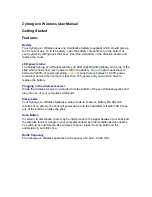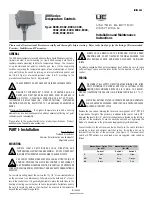
P
AGE
8
Preparation for Wiring 2.2
2.2.1 WIRING GUIDELINES
Electrical noise is a phenomenon typical of industrial environments. The following are
guidelines that must be followed to minimize the effect of noise upon any instrumentation.
2.2.1.1 INSTALLATION CONSIDERATIONS
Listed below are some of the common sources of electrical noise in the industrial environ-
ment:
• Ignition Transformers
• Arc Welders
• Mechanical contact relay(s)
• Solenoids
Before using any instrument near the devices listed, the instructions below should be fol-
lowed:
1. If the instrument is to be mounted in the same panel as any of the listed devices, separate
them by the largest distance possible. For maximum electrical noise reduction, the noise
generating devices should be mounted in a separate enclosure.
2. If possible, eliminate mechanical contact relay(s) and replace with solid state relays. If a
mechanical relay being powered by an instrument output device cannot be replaced, a solid
state relay can be used to isolate the instrument.
3. A separate isolation transformer to feed only instrumentation should be considered. The
transformer can isolate the instrument from noise found on the AC power input.
4. If the instrument is being installed on existing equipment, the wiring in the area should be
checked to insure that good wiring practices have been followed.
2.2.1.2 AC POWER WIRING
Earth Ground
The instrument includes noise suppression components that require an earth ground connec-
tion to function. To verify that a good earth ground is being attached, make a resistance
check from the instrument chassis to the nearest metal water pipe or proven earth ground.
This reading should not exceed 100 ohms. Use a 12 gauge (or heavier) insulated stranded
wire.
Neutral (For 115VAC)
It is good practice to assure that the AC neutral is at or near ground potential. To verify this, a
voltmeter check between neutral and ground should be done. On the AC range, the reading
should not be more than 50 millivolts. If it is greater than this amount, the secondary of this
AC transformer supplying the instrument should be checked by an electrician. A proper
neutral will help ensure maximum performance from the instrument.
2.2.1.3 WIRE ISOLATION
Four voltage levels of input and output wiring may be used with the unit:
• Analog input or output (i.e. thermocouple, RTD, VDC, mVDC or mADC)
• SPST Relays
• SSR driver output
• AC power
The only wires that should be run together are those of the same category. If they need to be
run parallel with any of the other lines, maintain a minimum 6 inch space between the wires.
If wires must cross each other, do so at 90 degrees. This will minimize the contact with each
other, do so at 90 degrees. This will minimize the contact with each other and reduces "cross
talk". "Cross talk" is due to the EMF (Electro Magnetic Flux) emitted by a wire as current
passes through it. This EMF can be picked up by other wires running the same bundle or
conduit.









































